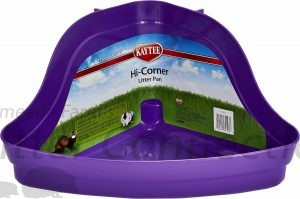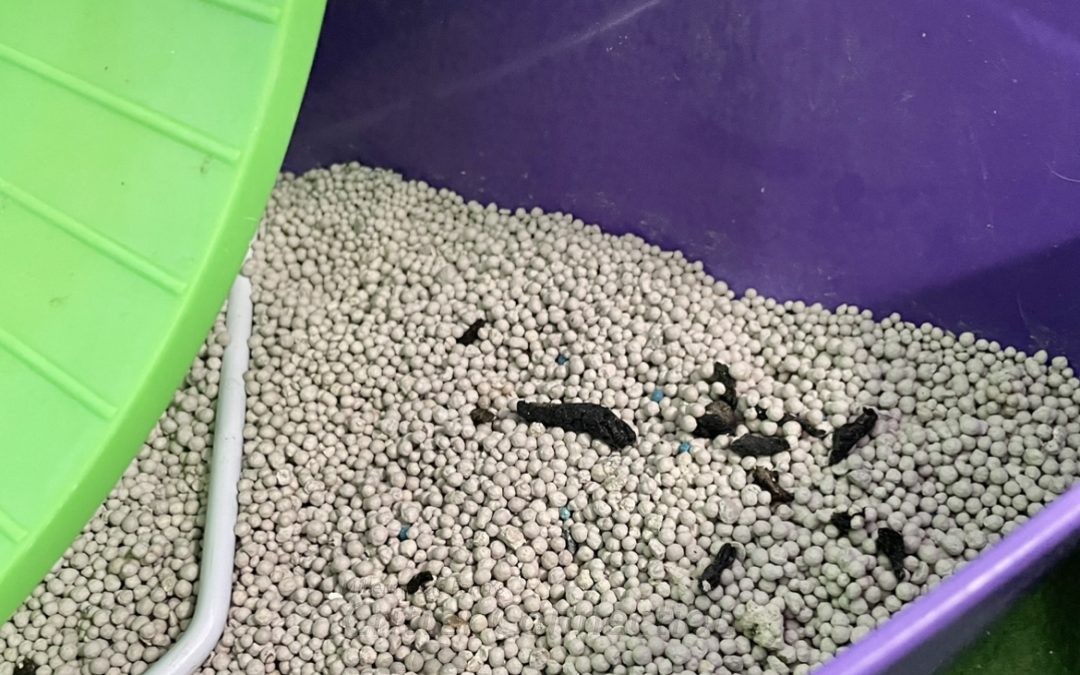Last Updated on August 25, 2022.
Litter pans are a great accessory to any cage as it is well worth your effort to try and litter train your hedgehog. A litter-trained hedgehog will save you cage cleaning time, decrease the amount of bedding needed, and increase the freedom you have with your pet. Litter trained hedgehogs are obviously much more suited to “free-roaming” in their own room or in an area of your home or apartment.

Probability of Use
- We once heard that it was a “crap shoot” whether or not your hedgehog would use the litter pan. We tend to agree!
- Some hedgehogs take to the litter pan and use it right away with little or no coaxing.
- Others refuse to use their litter pan despite any attempts on your part to try to teach them the purpose of the litter pan.
- One former customer emailed us and told us that her hedgehog suddenly started using the litter pan when it was two years old. Better late than never!
- Some hedgehogs prefer to use their litter pan as a sand or dust bath rather than for elimination. Dust bathing is harmless and is simply a natural thing for a hedgehog to do.
- Another customer emailed us and told us that his hedgehog was careful to eliminate on one side of the litter pan and dust bathe on the other.
- Your litter training success will depend partly on your patience and persistence, and partly on your hedgehog’s personality.
VIDEO.: Litter box training
Placement and Style
- The litter pan should have an entrance low enough for the hedgehog to easily climb in, and should be large enough for the hedgehog to climb in and turn around.
- Ferret corner litter pans such as the Super Pet Ferret Hi-Corner Litter Pan, Marchioro USA Corner Litter Pan for Small Animals and the Lixit Ferret Corner Litter Pan are a popular choice because they are high on the sides and back and low in the front. This style of pan takes up less cage space than other styles.
- Position the litter pan as far away as possible from the food dish, or place the litter pan wherever the hedgehog chooses to use the bathroom.
- Most healthy, caged animals do not eliminate where they eat or sleep provided their cage is large enough to accommodate separate areas.
- Placing the litter pan in a favored elimination area is the simplest and quickest method for success.
- One customer told us that his/her hedgehog decided to use the igloo as a litter box. So, she put the litter pan in the igloo and has had success ever since. We guess some hedgehogs just like to potty in private!
- Another option would be to invert an appropriately sized cardboard box (or modify one to your needs), and cut an entrance in it to go over the litter pan. Your hedgehog may prefer to do his “duty” in private.
- Please note that we offer litter pans at our shop as an individual item or discounted in our cage packages. We cannot ship litter pans.
Litter Substrate
- Some breeders do recommend using the same bedding in the cage and litter pan, but we suggest using a different substrate in the litter pan than what is used in the rest of the cage.
- Recommended types and brands of kitty litter vary between hedgehog enthusiasts.
- Non-clumping, clay kitty litter is a relatively popular substrate for litter pans.
- Some hedgehog enthusiasts recommend against using any clay litters for fear the dust can cause respiratory illnesses.
- Many owners prefer dust-free litter, but some find that their hedgehogs enjoy rolling in the litter like a dust bath.
- Others believe that no litter (including kitty litter) should be used other than the types that are relatively large pellets. One example of suggested pelleted litter is Yesterday’s News.
- Clumping kitty litter should be avoided because it can stick to the delicate areas of your hedgehog.
- As described by Plombom, clumping litter can cause “blockage of poop and urine, and in the case of male hedgehogs, [get] pulled up into the penile sheath, where [it] can trap the penis, block urine, cause sores and infections, and be deadly if not removed”.
- Refer to the Bedding Guides for more substrate ideas.
Special Litter Substrate
- Many hedgehog owners have had great success using special litter substrates.
- Hedgehogs may taste, then subsequently self-anoint with litter material.
- Some exploration of new cage or litter pan material is normal, however, litter should be removed immediately if the hedgehog consumes or attempts to ingest bedding material.
- The following information about Critter Litter is provided by Super Pet
- Critter Litter and Potty Litter are premium quality potty training material for training ferrets, rabbits, pet rats, and other small animals. It is specially formulated to be 99% dust free and is super absorbent. It is made from all natural non-toxic bentonite. Critter Litter absorbs moisture on contact, helping to eliminate pet waste odors. In combination with a potty training program, Critter Litter will reduce cage cleaning. PURCHASE POTTY LITTER HERE

When to Start
- Ideally, you should start training your hedgehog as soon as you get it home. The younger you start training, the more likely you are to succeed.
- Many breeders suggest leaving the wheel out of the cage during the hedgehog’s first few days in its new home. This will help the hedgehog establish a routine before it becomes a wheel-a-holic and starts to use the wheel as a litter pan.
Watch for Signs
- You may be able to observe certain clues that your hedgehog is getting ready to potty. As soon as you see these signs you will want to hurry and put your hedgehog in the litter pan.
- Most hedgehogs will need to relieve themselves shortly after waking up. According to Jennifer Plombom, “when your hedgehog is first awakened, their metabolism gears up, and peristalsis and muscle action increase – thus bowels and bladder start to do their jobs of elimination”. http://www.superpetusa.com/product-list/critter-litter-4-lb.html
- Watch for signs that they are going to begin to eliminate and then place them in their litter pan. When your hedgehog stops moving and points its tail up – get ready.
- Just after eating is another good time to watch for signs that your hedgehog should be placed in the litter pan.
Training
- Not all hedgehogs instantly use the litter pan, but don’t give up. With a little coaching on your part they may be persuaded.
- Place droppings inside the pan to help clue in the hedgehog where it should go. Providing litter box training to hedgehogs is very similar to cats.
- Some hedgehogs start using the litter pan on their own even after months of no interest.
- If you see your hedgehog using the litter pan, it may be a good idea to reward the behavior with a favorite treat.
- Once your hedgehog has started using the litter pan successfully, it may be beneficial to seed freshly cleaned litter pans with some dry excrement as a reminder to your hedgehog as to where it should go.
Accuracy
- Very few hedgehogs are going to be 100% accurate all of the time.
- When your hedgehog misses, move it to the litter pan.
- Some hedgehogs make a total mess of their wheels while other hedgehogs are considerate enough to stop and get off the wheel or hang their rear off the wheel before doing their business.
- Check out our Messy Wheel article for lots more tips.
- Unfortunately, there is no foolproof way to guarantee litter pan accuracy. Patience, persistence, time, and a little luck may lead you and your hedgehog to successful litter pan training.
Eliminating in Sleeping Areas
- It is very unusual for hedgehogs to eliminate in their sleeping areas.
- Most animals prefer to leave their smell as far as possible from where they are sleeping.
- Hedgehogs that do use their sleeping area as a litter pan may either need a smaller area to sleep or a litter substrate put in the sleeping/elimination area and a new sleeping area created.
Other Tips
- Try a different type of litter.
- Put the litter pan in a different corner of the cage.
- Place the litter pan in front of the wheel so your hedgehog has to walk through the litter pan to get to the wheel.
- Reserve the wheel for play time outside of the cage.
VIDEO.: Why is my hedgehog sleeping in the litter box?
Critter Connection Facebook 1/22/13
Christine Marie I have had success with putting the droppings inside the litterbox– she seems to get the hint.
If she is “forgetting”… As a reminder, at times, I will remove her wheel for the night– it’s amazing how well she goes in her litter box when she is not distracted!!
Also, I have found (this is my second hedgehog) that the older they get, the cleaner they become– they don’t want those poopy paws and will take the time to use the litter box on their own.
Emily Ocke I actually placed my wheel, when it had a stand, in the litter pan. I have a round pan I use and my hedgehog got the message.
Emily Meier I did the same. My litter pan is under/in front of the wheel so he has to walk through that first before he can get to the wheel .
Emily Meier It seems to work well except when I tried using toilet paper or paper towels he just dragged them into his bed lol.
I picked up my hedgehog yesterday and she ate, drank and explored her cage as soon as she got home, and is very sweet after she calms down. She even contained her potty habits to the litterbox! However, she was in it for most of the night using it as a dust bath and I noticed her scratching for a few seconds every four or five minutes. I have not seen her scratch yet today, but I woke her up only maybe 45 minutes ago. Is scratching after dust bathing normal? Will it dry out her skin if she’s doing it all night until I put her wheel in?
Playing in a dust bath is fairly common. It is something new and different as well as something many hedgehogs do in the wild. The scratching is probably just getting comfortable and something like we would do to fluff our hair or to try and tame our “bed head”. The dust could dry out her skin so keep an eye on it. Most likely her skin will be fine but your should keep an eye on it just in case.
I’m looking to switch my little one’s litter from clay kitty litter to either pelleted pine or pelleted aspen. I wanted to stick to something similar to her original bedding that she might be more familiar with since she eats her litter here and there. Thanks!
Primary Author: Gail Smith, Millermeade Farm’s Critter Connection
Contributors:
Christine Riddle, Riddles’ Hedgehogs; Shelly Fowler, Beach Bum Hedgehogs, Melissa Ramos
References
Plombom, Jennifer. How to Litter Train Your Hedgehog. The Hedgehog Welfare Society Newsletter. Issue 1, Retrieved on 10/12/11






